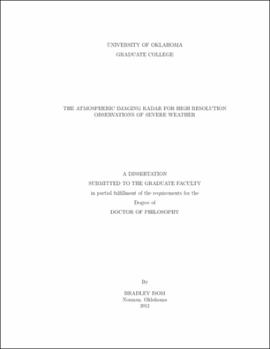| dc.contributor.advisor | Palmer, Robert D | |
| dc.creator | Isom, Bradley Michael | |
| dc.date.accessioned | 2019-05-01T17:22:57Z | |
| dc.date.available | 2019-05-01T17:22:57Z | |
| dc.date.issued | 2012 | |
| dc.identifier | 99114678302042 | |
| dc.identifier.uri | https://hdl.handle.net/11244/319406 | |
| dc.description.abstract | Mobile weather radars often utilize rapid scan strategies when collecting obser- vations of severe weather. Various techniques have been used to improve volume update times, including the use of agile and multi-beam radars. Imaging radars, similar in some respects to phased arrays, steer the radar beam in software, thus requiring no physical motion. In contrast to phased arrays, imaging radars gather data for an entire volume simultaneously within the field-of-view of the radar, which is defined by a broad transmit beam. As a result, imaging radars provide update rates significantly exceeding those of existing mobile radars, including phased arrays. The Atmospheric Radar Research Center at the University of Oklahoma is engaged in the design, construction and testing of a mobile imaging weather radar system called the Atmospheric Imaging Radar (AIR). | |
| dc.description.abstract | Initial tests performed with the AIR demonstrate the benefits and versatility of utilizing beamforming techniques to achieve high spatial and temporal resolution. Specifically, point target analysis was performed using several digital beamform- ing techniques. Adaptive algorithms allow for the improved resolution and clutter rejection when compared to traditional techniques. Additional experiments were conducted during three severe weather events in Oklahoma, including an isolated cell event with high surface winds, a squall line, and a non-tornadic cyclone. Sev- eral digital beamforming techniques were tested and analyzed, producing unique, simultaneous multi-beam measurements using the AIR. | |
| dc.description.abstract | The author made specific contributions to the field of radar meteorology in several areas. Overseeing the design and construction of the AIR was a signif- icant effort and involved the coordination of many smaller teams. Interacting with the members of each group and ensuring the success of the project was a primary focus throughout the venture. Meteorological imaging radars of the past have typically focused on boundary layer or upper atmospheric phenomena. The AIR's primary focus is to collect precipitation data from severe weather. Ap- plying well defined beamforming techniques, ranging from Fourier to adaptive algorithms like robust Capon and Amplitude and Phase Estimation (APES), to precipitation phenomena was a unique effort and has served to advance the use of adaptive array processing in radar meteorology. Exploration of irregular antenna spacing and drawing from the analogies between temporal and spatial process- ing led to the development of a technique that reduced the impact of grating lobes by unwrapping angular ambiguities. Ultimately, the author leaves having created a versatile platform capable of producing some of the highest resolution weather data available in the research community today, with opportunities to significantly advance the understanding of rapidly evolving weather phenomena and severe storms. | |
| dc.format.extent | 305 pages | |
| dc.format.medium | application.pdf | |
| dc.language | en_US | |
| dc.relation.requires | Adobe Acrobat Reader | |
| dc.subject | Radar meteorology | |
| dc.title | The Atmospheric Imaging Radar for High Resolution Observations of Severe Weather | |
| dc.type | text | |
| dc.type | document | |
| dc.thesis.degree | Ph.D. | |
| ou.group | College of Engineering::School of Electrical and Computer Engineering | |
